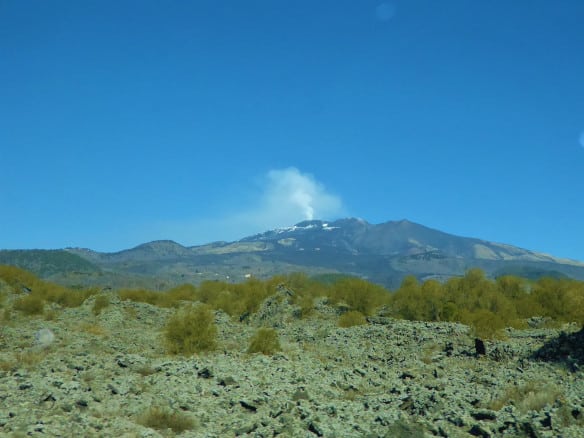Remarkable Mt. Etna, spewing from one of her four active summit craters. Apparently, she has about 300 vents and fissures on her flanks.

Mt. Etna, Europe’s Tallest Volcano
Mt. Etna, called Mongibello, or “beautiful mountain” in Sicilian dialect, is one beaut of a lady. Albeit a very large and temperamental lady, but nevertheless, a beauty. At 3,330 meters high (10,925 feet), she is Europe’s tallest volcano as well its most active.
As it has it, Mt. Etna has been particularly lively the last 60+ years, with several eruptions from the late 1980’s on, with a few large belches every year but one since 2001. (The last one of this writing was March 16, 2017.) There are four active craters forming the summit, but more than 300 vents and fissures along her flanks, with some craters several hundred meters in diameter.

At 2,000 meters is Il Crateri Silvestri, an area on the south flank of Mt. Etna, which is fissure-pocked and punctuated with several mini-cones from past eruptions. In the center just to the right of a blast of steam from one of the summit craters is a group of people who opted to hike to the top of this lava cone.
To the right of Mt. Etna is a smaller cone from another fissure’s blast. The front of the photo shows the lip of a crater (shown below). There is a small village to the left, Refugio Sapienza, from which intrepid travelers can take a cable car further up the mountain for an additional couple hundred dollars.

Many people enter this crater and leave messages written in stones. The largest display is at center, a lava stone maze many contribute to. This crater is a couple hundred meters across, as evidenced by the small figures making their way down the inside flank.
We spent several hours on and around Mt. Etna with local guide Alessio Patane, owner-operator of Sicily Grand Tour. He was a wealth of information about the mountain, its history of eruptions, its geology and lore.
One story involved an extended eruption George Lucas filmed and was able to include in his Star Wars Revenge of the Siti. I asked Alessio about a picture I’d seen of a house buried in lava up to the eaves. Alessio promptly drove us to the house in question, pointing out that it was the second floor of that dwelling that had been covered to the eaves by the lava.

Guide Alessio Patane of Grand Sicily Tour pointing out this house, buried two levels up to the eaves from a Mt. Etna eruption in the 1980’s.
Another fascinating stop was to crawl into a lava tube, one of many that riddle the surface below the flanks of Mt. Etna. Without getting all geeky in explanation, a lava tube is formed when flows of molten lava push and burrow down under a heavy crust of hardened lava rock; the molten stone melts the softer rock underneath, creating tunnels called lava tubes.

Alone, we would have driven past this small opening to a lava tube right on the roadway on Etna’s southeast flank. Alessio knew its location exactly. We donned hard hats, and flashlights in hand, went exploring.

From about four dozen meters, looking back towards the entrance to the lava tube. We had to scramble a bit to get in and out, and the hard hats came in handy in tight spots! The spotlight at center was Alessio’s beam pointing out a formation, somewhat like stalagmites, but made of iron, not calcium, that make jagged protrusions from the tube roof, hence the nickname, “dogsteeth”. Unfortunately, my close-up photos of the dogsteeth did not turn out well.
Our last stop before leaving Mt. Etna was the town of Zafferana, on the southeast flank of the mountain. In a 14 month series of eruptions between 1991-3, Zafferana was threatened by a steady albeit slow progression of lava heading straight toward town.
Italy’s best volcanologists and even the U.S.marines from a nearby base tried different tactics to divert the flow, using explosives and earth dams to redirect it. Nothing worked. But…the flow eventually stopped just a few meters from a house on the edge of town. The locals attributed this miracle to the intervention of Mother Mary and erected a statue nearby in her honor.

Note that the lava flow halted just a few meters from this house.
A last look at Mt. Etna from the northeast as we headed to Taormina.

Here you can see all four of Mt. Etna’s summit craters letting off steam. Note the lava field in the foreground, probably from one or several flows from the early 1990 eruptions, with shrubs and saplings just starting to grow. It takes about 20+ years for plant life to return to a lava field.
Be sure to check out our Italy page. Also, you may be interested in this article on the Pululahua Crater, the Underground and Active Volcano, as well as Snowmobiling on Iceland’s Second Largest Glacier.
Also see this piece on Sicily’s Aeolian Islands and Climbing and Walking Earth’s Highest and Lowest Points.

Carol Barbier Rolnick grew up in Japan and Southeast Asia, traveling extensively as a child through Asia, the Mideast and Europe on family vacations. Travel has continued as a priority through raising kids and continuing into retirement, extending adventures through the Americas, southern Africa, Asia, and repeat trips throughout Europe. Carol and her husband, Michael spent four summers based in Utrecht, The Netherlands, which has become like a second home. They are (still) aiming towards Australia-New Zealand and Antarctica to round off their continental travels.








